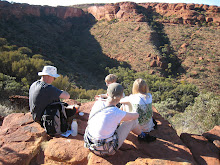
A few months before our first trip in 2007, Michelle bought the family's first digital camera. That was the only electronic item we brought on the trip. It was a fantastic addition to our travel experience, too. It took great photos and more than paid for itself on that very first trip. In 2008, with the prospect of a lot of time spent in transit, I bought a little iPod Nano so that the children would have access to some movies to watch and help pass the time. Annie also got her own camera. In 2009, we had three iPods so each child could watch their own thing. During longer drives in the little rental car, this was a life saver. Shelby got her own camera and so did I. The number of electronic items now numbered seven, with three battery chargers to keep them running. Still, all of them were pocket size and presented no difficulty in packing.
What we didn't have up to this point was any connectivity to the Internet or telephone. As we looked forward to our trip this year we have made a number of changes. Annie got an iPod Touch for Christmas and we all had a chance to play around with it's connectivity to the Internet. Liking what we saw, Michelle and I picked up our own (for half price, used on eBay), so now we all have our own personal media devices. We will have the ability to use email to contact our lodgings with arrival time information, use the Internet for travel information, and use "apps" to play games and track weather and currency exchange rates. We also have the ability to phone if necessary with Skype, though we will prefer to email.
The only drawback to the iPods is that their memory capacity is limited. This isn't much of an issue for a short trip. But after a couple of weeks, it would be nice to be able to change the content - movies, music, photos, etc. - to refresh it's usefulness. To do that, you need a computer. Having a computer would also enable us to download and manipulate our photos and movie clips as we go. It also makes it possible to experiment with blogging for the first time, giving others the opportunity to follow our progress through Central Europe.
What kind of computer would work best? The latest trend in on-the-go computing is "netbooks" which are essentially mini-laptops made smaller by eliminating the CD/DVD drive and using a smaller keyboard and screen. Many people love them. Unfortunately, we are a family of Mac users. As much as we would like to be able to enjoy the experience of using these cheap windows computers, we can't. We have tried and it is just not worth the headaches for us. We had high hopes for the newly-introduced Apple iPad. But coming out so soon before our trip, I was not comfortable with being able to get used to it in time, or trust it's versatility. Buying a full-size Macbook would have cost more than I was willing to pay, would have been heavier to carry than I preferred, and would have presented a real theft risk. Ultimately, I wound up buying a used Macbook Air on eBay. This is the ultra-thin, lightweight laptop made for travel that still has a full size keyboard and screen. The price was right so it is less of a theft risk, ideally compatible with our iPods and cameras, and very easy to pack.
So what about the "travel light" travel mentality while carrying around all these electronics? Well, without them, we would be traveling with a thick atlas for driving, four guide books, and a thick folder full of documents printed from our home computer. Those items alone would take up more space and add more weight to our bags than all of these small electronic items put together. It will also add an extraordinary level of convenience in the access of information over such an extended, transition-filled trip.
It remains to be seen whether or not all these items add to our overall travel experience, or detracts from it. It needs to be acknowledged that there is a certain value to being completely disconnected from the rest of the world while traveling to a foreign country. Being away from the constant flow of information, news, and contact with others helps focus your attention on the present and become enveloped in the culture. It will be our challenge to maintain a proper balance and use the electronics only to the extent that they serve as an asset, and not as a distraction...










